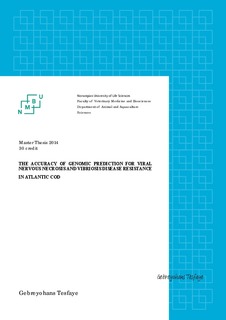| dc.description.abstract | The objective of this study was to estimate accuracy of genomic prediction for disease resistance to viral nervous necrosis and vibriosis using sparse and genome sequence SNP-data in Atlantic cod. The disease challenge test data of viral nervous necrosis and vibriosis used in this study were obtained from the National Atlantic cod breeding program which is running in Tromsø, Norway and we used disease challenge test data of year-class 2009 for both traits. Disease resistance for both traits was measured as survival at a fixed point in time and assessed as a binary variable. We obtained the result of challenge test data of 707 and 728 individuals for viral nervous necrosis and vibriosis respectively. The individuals came from75 full-sib and half-sib families for both diseases and the number of individuals per family varied from 7 to 20 (average of 9.7) in viral nervous necrosis, and 6 to 10 in vibriosis. On top of pedigree information of 1,743 individuals, three genotype data sets were used in this study, and based on these data sets three different genomic relation matrices were calculated. These were SPARSE8 (genotype data of 283 SNP markers at chromosome 8 of 1,743 individuals), SPARSE GENOME (1,577 individuals’ genotype data of 8,658 SNP markers across the entire genome) and DENSE8 (imputed high density genotypes (759,270 SNPs) of chromosome 8 of 1,743 individuals). The genomic relation matrices were used in the GBLUP with polygenic models to estimate the variance components which were explained by the genomic information, and the genomic estimated breeding values using ASReml software. Fivefold within-family cross validations were carried out by randomly masking 20% of phenotypic records within each family in order to evaluate the accuracy of prediction for the viral nervous necrosis disease trait. Each observation was masked once and 141 phenotypes were masked in the first, second and third cross validation tests, whereas 142 phenotypes were masked in the fourth and fifth cross validation tests. Finally, the phenotypic values of the masked individuals were predicted based on the 566 or 565 phenotypic observations of the unmasked individuals. In the case of a between- families cross validation test, the phenotypic values of 20% of the families were masked at a time and their phenotypic values were predicted from the other families’ phenotypic values. A total of 15 families were masked in each cross validation and the total masked phenotypes were 140, 142, 136, 137 and 153 in the first, second, third, fourth and fifth cross validations respectively. The accuracy of prediction was calculated based on the correlation between the predicted phenotypic values and observed phenotypic values. The results of analysis showed that for the trait disease resistance to viral nervous necrosis, heritability estimates of the trait using the traditional BLUP (h2= 0.359) and GBLUP (SPARSE8) (h2= 0.355) were almost equal. However, GBLUP (DENSE8) (h2= 0.335) and SPARSE GENOME (h2= 0.371) had the lowest and the highest heritability estimates respectively, but these differences were not significant according to their log- likelihood estimates. In the case of vibriosis, our data were not able to distinguish between the genetic variation explained by the genomic information and the pedigree information. The SPARSE GENOME gave a 0.117 heritability estimate by fixing the variance explained by pedigree information at the boundary 0. According to a within-family cross validation test for viral nervous necrosis, the accuracies were estimated as 0.329 in the case of the traditional BLUP and GBLUP (DENSE8) models, but 0.336 in the SPARSE GENOME model. In addition to this, results of between-family cross validation showed that the accuracy of prediction of the DENSE8 (0.15) was less than that of the SPARSE8 (0.16). In our study we found a high heritability of resistance to viral nervous necrosis in Atlantic cod in all models. However, our heritability estimate was lower than the extremely high estimates of other studies in Atlantic cod. The total number of fish, the average number of fish per family, and the model we used in our study could be possible reasons for our relatively lower estimate of heritability for disease resistance to viral nervous necrosis. In our study, the accuracy of prediction of the genomic estimated breeding values using the sparse SNP markers (SPARSE GENOME) did not show a big difference compared with the traditional estimated breeding values, and this could be due to the fact that the phenotypical and genotypical data we used for training was too small to accurately capture the whole fraction of the variance explained by the SNP chip. Moreover, the accuracy of prediction of imputed high density genotypes (DENSE8) of chromosome 8 for disease resistance for viral nervous necrosis was not better than that of SPARSE 8, and this could be because in within- family genomic selection, big segments are inherited together and so the sparse SNPs could be sufficient to detect the chromosome segments. The low heritability estimate of our study to the trait disease resistance for vibriosis is consistent across all studies. However, the accuracy of genomic prediction could not be assessed by cross-validation, since we were not able to distinguish the genetic variance explained by the genomic and pedigree information. In conclusion, for both traits more phenotypic and genotypic data are required in order to properly evaluate the accuracy of prediction of the genomic information. | nb_NO |
